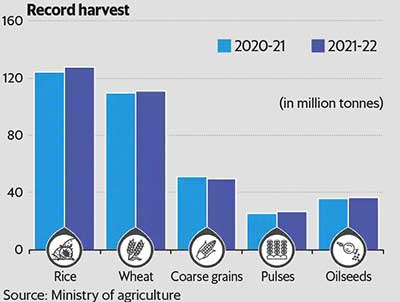Relevance: GS-3: Major crops-cropping patterns in various parts of the country; transport and marketing of agricultural produce and issues and related constraints
Key Phrases: Food production, Inflation, Foodgrains, Pulses, Oilseeds, base effect, Crude oil prices, food processing.
Why in News?
-
Food production in India is estimated to touch a record 316 million tonnes in 2021-22, according to the Second Advance Estimates of the Ministry of Agriculture. Is a bumper harvest enough to keep retail food prices in check, let’s take a look.
Key Points:
- According to the 2nd advance estimates released by the Ministry of
Agriculture, the production of foodgrains, including rice, wheat,
pulses, and coarse cereals, is estimated at 316 million tonnes(mt) in FY22,
which is 8% more than the five-year average.
- Additionally, Oilseed production is estimated at over 37 million tonnes, 12% higher than the five-year average.
- Sugarcane production too is set to rise by 10% compared to the five-year average.
- The record production is attributable to normal monsoon rains during June-September 2021.
Impact on Retail food prices:
- The moderate food inflation in 2021 was a result of base
effect as food prices grew by double digits in 2020 after the coronavirus
outbreak.
- Retail food inflation fell to 0.7% in September 2021, but climbed to a 13-month high of 5.4% in January.
- Consumers are paying steep prices for staples like pulses and edible oils despite the Centre taking steps like reducing import duties.

- However, What consumers pay for food depends on several factors.
- While higher production of pulses and oilseeds is a relief, since India is also dependent on imports to meet domestic consumption, how global prices move will be a determining factor.
- This is particularly true for oilseeds where India is acutely dependent on imports to meet half of its domestic requirement. (imports around 13 million tonnes of edible oil)
- Last year, India’s edible oil import bill shot to ₹1.2 trillion.
- In addition, the upcoming Kharif crop season, planting for which begins in June, will be critical, as will be vegetable output, which varies due to seasonal factors.
Concerns:
- The foremost risk is rising crude oil prices, which crossed $95 a barrel
recently, the highest since 2014, amid heightened tensions between Russia
and Ukraine.
- Analysts say crude prices will cross $100 a barrel and may even surpass $125 by summer.
- High oil prices lead to higher fertilizer and input costs for farming, diversion of food crops to produce biofuels, and high shipping costs.
- India has not raised fuel prices for more than three months and a hike is expected in March after state elections are over. It will likely impact food prices.
- Rising crude and fertilizer prices may also force the Centre to foot a higher fertilizer subsidy bill to keep farming costs in check.
- Except for oilseeds and pulses, India is largely self-sufficient in food
production.
- The government is sitting on massive public stocks of rice and wheat which can be off-loaded via the public distribution system or through open market sales when prices rise.
- The biggest problem, however, may emerge in edible oils where import duties have already been slashed with little room for further cuts.
- Indians consume about 28 million tonnes of pulses and imports 3-5
million tonnes every year.
- The number could go up, as more people experience improvement in their living standards and can afford to consume more protein.
- Moreover, excess rains in September-October delayed harvest and damaged crops in some regions, which also needs to be looked into.
Way Forward:
- What is really needed is to put in place a new set of incentives for the crops that are in short supply and for crops that India could produce competitively for the world market, backed up with a robust agro-processing and food processing industry.
- Farmers have to be weaned off rice and wheat and subsidy, not forcibly prised off these substances, to which they have been addicted for more than half a century.
Conclusion:
- This year’s Padma awardee included two farmers, one from Uttar Pradesh, who has diversified from grain to flowers, vegetables and much else. One Padma does not a paradigm shift make; we need an integrated set of incentives and investment in market linkages for the farmer to move out of grain and into more diverse crops.
Source: Live Mint
Mains Question:
Q. A record harvest in agriculture in India in reality is a bane for the Government, Producer and Consumer. Comment (250 Words).







